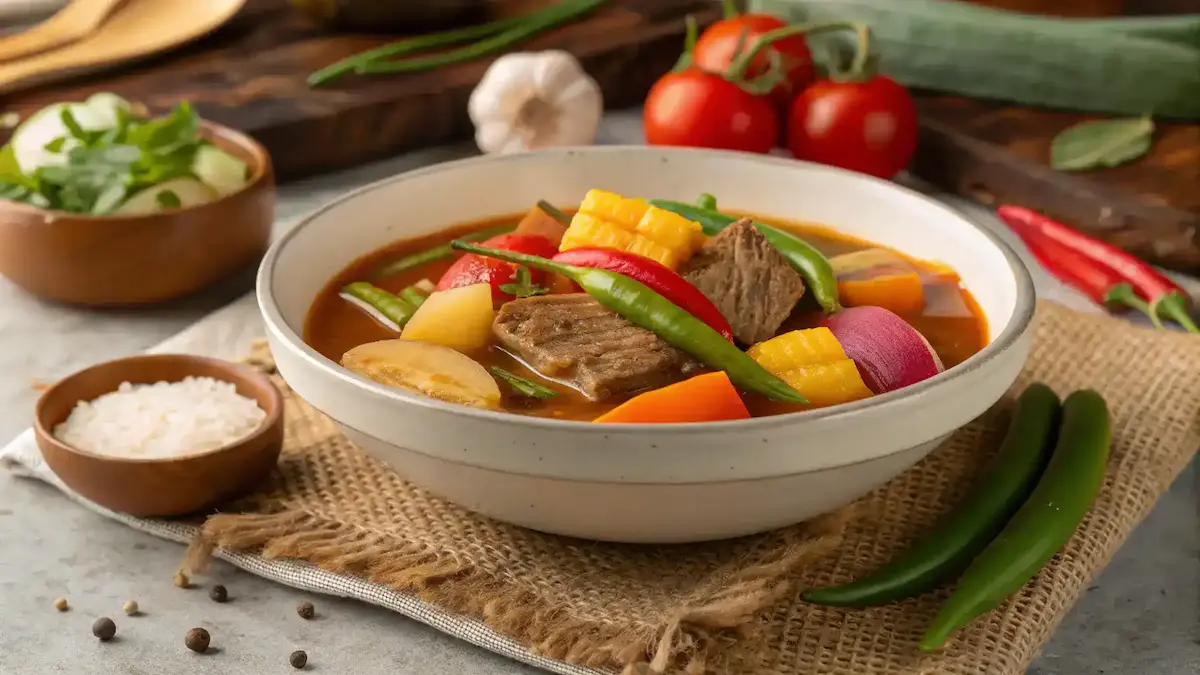Welcome to the world of Sinigang recipe, a beloved Filipino dish that warms the heart and nourishes the soul. This Sinigang Recipe is not just a meal; it’s a comforting experience that brings families together. With its rich flavors and vibrant ingredients, it’s a dish that everyone can enjoy. Not only is it packed with health benefits, but it also serves as a low-calorie option, making it perfect for those mindful of their diet. Moreover, the sour profile, typically achieved through tamarind, is known to boost immune support. So, gather your loved ones and let’s dive into this delightful culinary journey!
Table of Contents

Sinigang Recipe
Equipment
- 1 Large Pot For boiling the broth and cooking the ingredients.
Ingredients
Protein
- 1 kg Fish (like bangus), Chicken, or Beef Choose one based on preference.
Souring Agent
- 200 g Tamarind Traditional souring agent.
- 100 g Calamansi or Green Mango Optional for a unique twist.
Vegetables
- 1 cup Radish Chopped.
- 1 cup Eggplant Sliced.
- 1 cup Green Beans Trimmed.
- 2 cups Spinach Fresh.
Seasoning
- 2 tbsp Fish Sauce To taste.
- to taste Salt To taste.
- 4 cups Water or Broth As a base for the soup.
Instructions
Preparation
- Begin by chopping your chosen vegetables and protein into bite-sized pieces. This will save you time later on.
Broth Creation
- In a large pot, bring water or vegetable broth to a boil. Using broth adds depth to the flavor.
Add Protein
- Introduce your protein choice and simmer until fully cooked. This usually takes about 10-15 minutes, depending on the protein.
Incorporate Vegetables
- Gradually add the vegetables, starting with those that take longer to cook, like radish and eggplant. This ensures everything is perfectly tender.
Add Souring Agent
- Stir in the tamarind or other souring agents, allowing the flavors to meld for about 10-15 minutes. This step is crucial for that signature Sinigang taste.
Season to Taste
- Adjust with fish sauce or salt, ensuring a balanced flavor profile. Taste as you go to achieve your desired flavor.
Serve
- Enjoy your Sinigang warm, garnished with fresh herbs if desired. This adds a lovely touch and enhances the presentation.
Notes
| Calories | Fat | Protein | Carbs |
|---|---|---|---|
| 250 | 10g | 20g | 30g |
Key Benefits
The Sinigang recipe is not just a delightful dish; it offers numerous health benefits. Packed with vitamins and minerals from fresh vegetables and lean proteins, it serves as a nutritious comfort food. Here are some key perks of this amazing dish:
- Health Benefits: Sinigang is loaded with fresh vegetables like radish, eggplant, and spinach, which are rich in vitamins. These nutrients help support your overall health.
- Comfort Food: There’s something incredibly soothing about a warm bowl of Sinigang. It’s perfect for those chilly days or when you need a little pick-me-up.
- Low-Calorie Option: If you’re watching your diet, Sinigang is a fantastic choice. It’s low in calories, allowing you to enjoy a hearty meal without the guilt.
- Immune Support: The sour profile of Sinigang, typically achieved through tamarind, is known to boost the immune system. This means you’re not just enjoying a tasty dish; you’re also giving your body a little extra love.
- Family-Friendly: Sinigang is a dish that everyone can enjoy. Whether you’re serving it to kids or adults, its flavorful profile appeals to all ages.
In summary, the Sinigang recipe is a wonderful blend of nutrition and comfort. It’s a dish that not only warms your heart but also nourishes your body, making it a must-try for anyone looking to enjoy a wholesome meal.
Ingredients
To create an authentic Sinigang recipe, gather the following key ingredients:
- Protein: Choose from fish (like bangus), chicken, or beef, depending on your preference. Each option brings its unique flavor to the dish.
- Souring Agent: Tamarind is traditional, but you can also use calamansi or green mango for a unique twist. This element is crucial for achieving that signature tang.
- Vegetables: Incorporate radish, eggplant, green beans, and spinach for a colorful and nutritious dish. Fresh vegetables not only enhance the flavor but also add essential vitamins.
- Seasoning: Use fish sauce or salt to enhance flavors, and don’t forget to add water or broth as a base. This will create a rich and savory broth that ties everything together.

By selecting these ingredients, you’re not just preparing a meal; you’re crafting a comforting bowl of Sinigang that’s rich in nutrients and flavor. This dish is not only family-friendly but also a wonderful way to introduce the vibrant tastes of Filipino cuisine into your home. So, let’s dive into the cooking process and bring this delightful Sinigang recipe to life!
How to Make Sinigang Recipe
Making Sinigang is straightforward and rewarding. Follow these simple steps to create a flavorful dish that your family will love.
- Prepare the Ingredients: Begin by chopping your chosen vegetables and protein into bite-sized pieces. This will save you time later on.
- Create the Broth: In a large pot, bring water or vegetable broth to a boil. Using broth adds depth to the flavor.
- Add Protein: Introduce your protein choice and simmer until fully cooked. This usually takes about 10-15 minutes, depending on the protein.
- Incorporate Vegetables: Gradually add the vegetables, starting with those that take longer to cook, like radish and eggplant. This ensures everything is perfectly tender.
- Add the Souring Agent: Stir in the tamarind or other souring agents, allowing the flavors to meld for about 10-15 minutes. This step is crucial for that signature Sinigang taste.
- Season to Taste: Adjust with fish sauce or salt, ensuring a balanced flavor profile. Taste as you go to achieve your desired flavor.
- Serve Hot: Enjoy your Sinigang warm, garnished with fresh herbs if desired. This adds a lovely touch and enhances the presentation.

By following these steps, you’ll have a delicious Sinigang recipe that not only warms the heart but also nourishes the body.
Pro Tips, Variations & Common Problems
To elevate your Sinigang, consider these pro tips:
- Ingredient Substitutions: If tamarind is unavailable, lemon juice or vinegar can serve as effective substitutes. This way, you can still achieve that signature sour flavor.
- Flavor Adjustments: Taste as you go! If the dish is too sour, balance it with a pinch of sugar. This small addition can make a significant difference.
- Common Problems: If your broth lacks depth, try adding more vegetables or a splash of soy sauce for umami. Additionally, if the soup is too salty, add more water or broth to dilute it.
Variations can include using different proteins like shrimp or tofu for a vegetarian option, ensuring everyone can enjoy this dish. For instance, using fish like bangus adds a delightful twist, while chicken provides a comforting, hearty feel.
Moreover, you can experiment with different vegetables. For example, adding sweet potatoes or taro can introduce a unique texture and flavor. Furthermore, consider incorporating herbs like lemongrass or ginger for an aromatic touch.
Lastly, if you find your Sinigang too thick, simply add more broth or water until you reach your desired consistency. This flexibility allows you to customize the dish to your liking, making your Sinigang recipe truly your own.
Serving Suggestions
Sinigang is traditionally served hot and fresh, making it a comforting centerpiece for any meal. To enhance your dining experience, consider these delightful serving suggestions:
- Steamed Jasmine Rice: Serve your Sinigang alongside fluffy jasmine rice. This classic pairing allows the rice to soak up the flavorful broth, creating a satisfying bite.
- Refreshing Side Salad: For a crisp contrast, a simple side salad with cucumbers, tomatoes, and a light vinaigrette complements the dish beautifully. This addition not only adds color but also balances the rich flavors of Sinigang.
- Fried Plantains: Another delightful option is to serve fried plantains. Their sweetness provides a lovely contrast to the sourness of the soup, making each bite a unique experience.
- Crispy Tofu: If you’re looking for a vegetarian twist, crispy tofu can be a fantastic side. It adds texture and protein, ensuring everyone at the table enjoys the meal.
- Garnishes: Finally, don’t forget to garnish your Sinigang with fresh herbs like cilantro or green onions. This not only enhances the visual appeal but also adds a burst of freshness to each serving.
By incorporating these serving suggestions, you can elevate your Sinigang recipe into a memorable dining experience. Whether you’re sharing it with family or friends, these accompaniments will surely impress your guests and create a warm, inviting atmosphere.
Preserving and Reheating Sinigang Recipe
To ensure your Sinigang Recipe remains as delightful as the day you made it, proper storage and reheating are essential. Firstly, when it comes to storage, place your Sinigang in airtight containers. This method helps to lock in flavors and maintain freshness. In the refrigerator, your Sinigang will stay fresh for up to three days. If you want to keep it longer, consider freezing it. In the freezer, it can last for up to three months.
However, remember to label your containers with the date to keep track of freshness. Additionally, when freezing, portioning the Sinigang into smaller containers can make reheating easier. To prevent spoilage or bacterial growth, always ensure that the Sinigang cools to room temperature before sealing it in containers. This practice minimizes condensation, which can lead to spoilage.
Reheating Methods
When it’s time to enjoy your Sinigang again, reheating it properly is key to preserving its taste and texture. The stovetop is the best method for reheating, as it allows for even warming. To do this, pour your Sinigang into a pot and add a splash of water or broth. This addition helps maintain moisture and prevents the dish from drying out. Heat it over medium-low heat, stirring occasionally, until it reaches your desired temperature. Alternatively, if you’re short on time, the microwave can be a quick option.
Transfer your Sinigang to a microwave-safe bowl, cover it loosely with a microwave-safe lid, and heat in one-minute intervals, stirring in between. This technique ensures even heating. If you prefer a crispy texture, consider using an air fryer. Simply place the Sinigang in the air fryer basket, add a little water, and heat at a low temperature for about 5-7 minutes. Regardless of the method, always taste and adjust the seasoning if necessary. This step is particularly important, as flavors can mellow during storage. By following these reheating methods, you can enjoy your Sinigang Recipe just as much as when it was freshly made!
Conclusion
As you wrap up your culinary adventure with this authentic Sinigang recipe, remember that cooking is not just about the end result; it’s about the joy of creating something delicious from scratch. This dish, with its vibrant flavors and comforting warmth, is a fantastic choice for any occasion, whether it’s a cozy family dinner or a gathering with friends. Moreover, the simplicity and versatility of Sinigang make it accessible for cooks of all skill levels. So, I encourage you to dive in and experience the delightful process of making this Filipino comfort food yourself!
Additionally, I would love to hear about your experience! Feel free to share your results in the comments below or ask any questions you might have. Remember, cooking is all about experimentation, so don’t hesitate to try different proteins or vegetables to make this dish your own. For instance, you could swap tamarind for calamansi or even add some leafy greens for an extra nutritional boost. Ultimately, the possibilities are endless, and that’s what makes cooking so much fun!
In conclusion, this Sinigang recipe is not only a delicious meal but also a wonderful way to connect with Filipino heritage and culture. So, gather your ingredients, invite your loved ones to join you in the kitchen, and enjoy the process of creating something truly special. Happy cooking!
Frequently Asked Questions about Sinigang Recipe
Curious about Sinigang? Here are some common questions and answers to help you create the perfect dish!
1. What is Sinigang?
Sinigang is a traditional Filipino soup known for its sour flavor, typically achieved through tamarind. This comforting dish is packed with fresh vegetables and protein, making it a nutritious choice for family meals.
2. What can I use as a souring agent besides tamarind?
If tamarind isn’t available, you can use calamansi, green mango, or even lemon juice as alternatives. Each option provides a unique twist to the Sinigang recipe while still delivering that signature sour taste.
3. Can I make Sinigang vegetarian?
Absolutely! You can easily make a vegetarian version by using vegetable broth and tofu or mushrooms as your protein. Additionally, load up on fresh vegetables like radish, eggplant, and spinach for a hearty meal.
4. How do I store leftover Sinigang?
To preserve your Sinigang, store it in airtight containers in the refrigerator for up to three days. For longer storage, consider freezing portions. When reheating, add a splash of water to maintain moisture and prevent drying out.
5. What should I serve with Sinigang?
Sinigang pairs wonderfully with steamed jasmine rice, which helps soak up the flavorful broth. You can also serve it with a side salad or fried plantains for added texture and contrast.
Your Flavorful Feedback
There are no reviews yet. Be the first one to write one.

